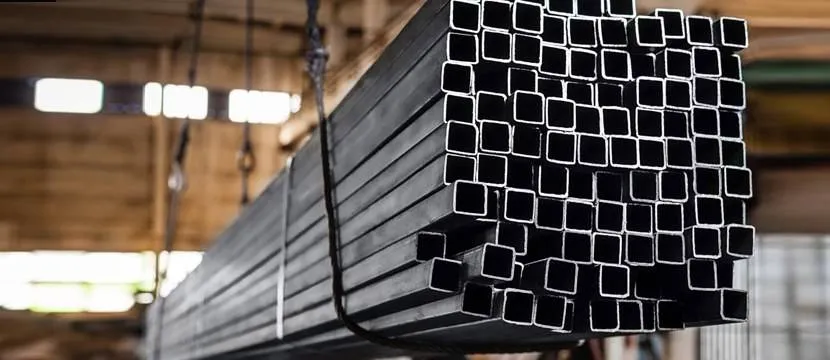EN 10210-2 S355J2H Square & Rectangular Hollow Sections (SHS/RHS)
Europe We offer a large variety of structural hollow sections-square, rectangular and circular-used throughout Europe and the world in steel construction, mechanical engineering, infrastructure and energy projects. They are an effective and really efficient choice in both structures and structures, due to their efficiency, clean lines, and adaptability.
EN 10210-2 of the numerous European standards incorporates hot-finished structural hollow sections of non-alloy and fine-grain steels. S355J2H is one of the most popular grades with the balanced strength, ductility, and toughness. Manufactured in square hollow sections (SHS) and rectangular hollow sections (RHS), S355J2H becomes an option of choice by engineers who require assurance under harsh conditions.
What EN 10210-2 Covers
The EN 10210 standard is divided into two parts:
- EN 10210-1: Technical delivery conditions.
- EN 10210-2: Tolerances, dimensions, and sectional properties.
Together, they provide the framework for hot-finished structural hollow sections. Hot-finished means the sections are formed at high temperatures, ensuring homogeneity, better impact resistance, and reduced residual stresses compared to cold-formed equivalents (EN 10219).
S355J2H Explained
The designation S355J2H breaks down as follows:
- S = Structural steel.
- 355 = Minimum yield strength of 355 MPa (for ≤16 mm thickness).
- J2 = Impact energy of 27 Joules at –20 °C, guaranteeing low-temperature toughness.
- H = Hollow section.
This combination ensures that S355J2H SHS/RHS offers high strength, good weldability, and toughness even in sub-zero conditions—making it suitable for bridges, offshore platforms, and heavy-duty frameworks.
Mechanical Properties
For S355J2H, the typical mechanical requirements are:
- Yield strength (ReH):
- 355 MPa for ≤16 mm wall thickness.
- 345 MPa for >16–40 mm.
- 335 MPa for >40–63 mm.
- 355 MPa for ≤16 mm wall thickness.
- Tensile strength (Rm):
- 470–630 MPa.
- 470–630 MPa.
- Elongation (A):
- ≥22% (depending on thickness and test direction).
- ≥22% (depending on thickness and test direction).
- Impact toughness (KV):
- 27 J at –20 °C (Charpy V-notch test).
- 27 J at –20 °C (Charpy V-notch test).
This combination of high yield strength, good ductility, and tested toughness ensures safety in dynamic and cold-weather conditions.
Advantages of Hot-Finished SHS/RHS
Compared to cold-formed hollow sections (EN 10219 S355J2H), hot-finished EN 10210 sections provide several advantages:
- Improved Ductility & Toughness
Hot finishing eliminates residual stresses from cold forming, reducing risk of brittle fracture. - Consistent Mechanical Properties
Uniform properties across the section, even at corners, allow full utilization of design capacity. - Superior Weldability
With controlled carbon equivalent (Ceq), welding can be carried out without preheating in most cases. - Structural Reliability
Better performance under fatigue, dynamic, or impact loading, especially at low temperatures.
Tolerances & Dimensions (per EN 10210-2)
Square Hollow Sections (SHS):
- Side dimension: 40×40 mm up to 500×500 mm.
- Wall thickness: 3 mm to 20 mm.
- Lengths: Standard 6 m, 12 m; custom lengths available.
Rectangular Hollow Sections (RHS):
- Side dimension: 50×30 mm up to 800×400 mm.
- Wall thickness: 3 mm to 20 mm.
- Lengths: Standard 6 m, 12 m.
Tolerances:
- Outside dimensions: ±1% (minimum ±0.5 mm, maximum ±10 mm).
- Wall thickness: ±10% (±0.2 mm minimum).
- Squareness: ≤2% of side.
- Twist: ≤2 mm per meter length.
- Concavity/convexity: within 1% of side.
Applications of S355J2H SHS & RHS
- Civil & Structural Engineering
- Beams, columns, and bracing in buildings.
- Bridge trusses and pylons.
- Beams, columns, and bracing in buildings.
- Mechanical & Offshore Structures
- Offshore oil and gas platforms.
- Wind turbine towers and foundations.
- Offshore oil and gas platforms.
- Architectural Use
- Clean, aesthetic lines for exposed frameworks.
- Stadiums, airports, and exhibition halls.
- Clean, aesthetic lines for exposed frameworks.
- Infrastructure
- Rail and road structures.
- Transmission towers.
- Rail and road structures.
S355J2H’s combination of strength and impact toughness makes it especially attractive for cold regions (e.g., Northern Europe, Canada, Russia).
Comparison with ASTM Standards
- ASTM A500 Grade B/C: Lower toughness, looser tolerances, and no mandatory impact test.
- ASTM A1085 (50 ksi / 345 MPa): Similar strength and toughness requirements, with controlled yield strength and tight tolerances.
- CSA G40.21 350W / 350WT: Comparable in Canada, with WT grades guaranteeing low-temperature toughness.
Thus, EN 10210-2 S355J2H is broadly equivalent to ASTM A1085 and CSA G40.21 350WT in performance, especially for cold-weather use.
Sustainability & Efficiency
S355J2H hollow sections also support sustainable construction:
- Weight efficiency: SHS/RHS maximize load-bearing capacity with minimal steel tonnage.
- Recyclability: 100% recyclable with no degradation of mechanical properties.
- Reduced fabrication waste: Precision tolerances reduce off-cuts and machining.
These benefits align with modern environmental standards such as LEED and BREEAM certifications.
Conclusion
EN 10210-2 S355J2H square and rectangular hollow sections are the ultimate slim sections with a high level of strength, toughness, weldability and dimensional accuracy- are an ideal solution to meet the high requirements on the structural applications. Hot-formed SHS and RHS can be offered with high levels of reliability over cold-formed solutions and are guaranteed safe in seismic, offshore and low-temperature applications.
When it comes to performance on a par with ASTM A1085 or CSA G40.21 350WT, S355J2H takes preeminence as the European standard of preference. Constantly fuelling efficiencies and robustness in the construction industry, whether employed in bridges, buildings or offshore platforms or even outstanding architectural structures, this material remains to be of essence when it comes to construction all around the world.







